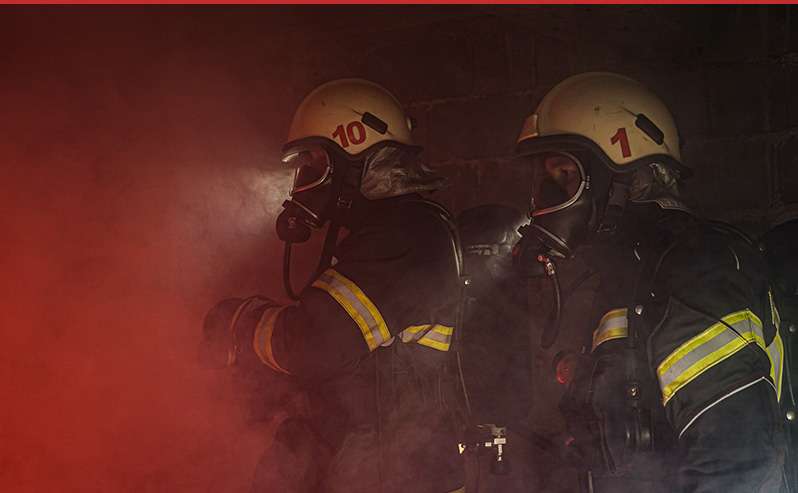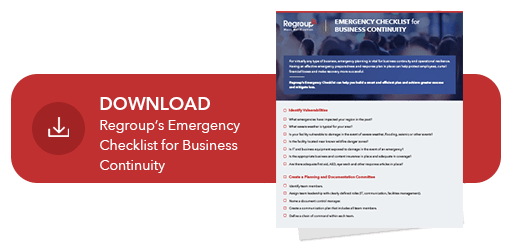
Table of Contents
- Severe weather, flooding, earthquakes, active shooter events and other disasters have a direct impact on business continuity. Having an emergency plan for your business can help in risk mitigation, protect your employees and assets and speed the recovery process.
- Ready to see more? You can schedule a no-obligation demo of Regroup’s powerful notification system here.
Emergency Planning for Business – a Guide to Disaster Recovery
Severe weather, flooding, earthquakes, active shooter events and other disasters have a direct impact on business continuity. Having an emergency plan for your business can help in risk mitigation, protect your employees and assets and speed the recovery process.
For businesses and organizations of all sizes, emergency preparedness and planning can mean the difference between operational resilience and staggering losses. It is, therefore, crucial for all types of organizations to take seriously the need for planning and preparing for unexpected calamities before they occur.
The most solid of business plans can be weakened by incidents like severe weather, other natural disasters, active shooter events, fires, and even pandemics like COVID-19. Organizations that plan ahead can better respond to moments of crisis and recover more adeptly after a major event.
The most important aspect of any emergency plan is planning. This involves identifying areas of risk, key personnel and stakeholders, potential scenarios, and how to respond quickly to curtail the risks to life and property.
Start with an Emergency Audit
The value of prevention cannot be overstated. In many work and volunteer environments, it can be easy to overlook certain hazards that have the potential to cause injury or loss of facility assets. Additionally, certain regions may be more prone to severe weather and natural disasters including hurricanes, flooding and wildfires.
A regularly planned audit of your facilities is, therefore, essential to ensuring a safe environment for employees and other staff. Start by a thorough inspection of your facilities. Are there adequate safety precautions being taken? Do you have the necessary first response equipment (fire extinguishers, first aid, eyewash stations, AED machines)? Are your team members trained in emergency preparedness and response?
Along with these types of audits, it may be beneficial to analyze the structural soundness of your physical facilities and equipment. Since damage from severe weather can incapacitate a business for weeks — or even months — organizations must ensure their facilities are resistant to inclement weather and other natural conditions.
Organizations should also consider the safety of newly remote or distributed workforces while auditing their emergency response plans. As working from home is becoming more of a norm, post-COVID-19, planning for severe weather and other outages must accompany your preparedness plans.
Conducting a full audit of your current safety and emergency preparedness will give you a clear picture of potential threats, weaknesses, and opportunities to improve your emergency planning and response.
Some other actions you can take during this process might include:
- Gain insights from other local business owners
- Take inventory of property, content, and business insurance
- Conduct historical research on natural disasters and other events in your immediate vicinity
Formulate a Smart Disaster Recovery Communications Plan
With any emergency preparedness effort, solidifying your communications strategy is essential to establishing a chain of command and how information is shared during unexpected events. Because your responses will likely be different, depending on the event, having your communication plan in writing becomes an important part of your overall strategy.
Keep your written plan simple and easy to follow in the event of an emergency. It should include the following key elements:
- Make sure your emergency preparedness efforts address communication. This includes a mass notification system that can alert team members — wherever they may be. A platform like Regroup Mass Notification can make it faster (and more reliable) when reaching out to team members during emergencies. Regroup can reach thousands of people with easy 2-tap messaging from any desktop or mobile device. Additionally, Regroup allows for seamless integration with existing communication channels simultaneously – social media, websites, desktop alerts, digital signage, and PA systems.
- Identify team member roles during a disaster as well as their expected responsibilities. . Those in senior management — who will act as the crisis communications team — should also be defined in writing. Identifying those team members who can provide first aid, or who are trained in CPR, is also important for your plan to be successful.
Develop a Business Continuity Plan
Business continuity following an emergency or disaster can be challenging but is certainly not impossible. As always, planning ahead, identifying stakeholders and their roles, and having contingency plans in place can help you keep your business operating as you respond and recover from a disaster or emergency situation.
- Create a checklist of all of the office jobs needed for the company to continue functioning post-disaster, noting where they would relocate to and how soon these roles would need to be operational.
- Keep an inventory of necessary office equipment such as computers and telephones and server equipment.
- Create a work from home plan where appropriate. If such a scheme isn’t a possibility, plan ahead for alternate facilities on a temporary basis.
- For a newly distributed workforce, have a solid communication plan in place that includes notifications to mobile devices, desktops, email, texts/SMS, and company intranets.

Harnessing technology to maintain business continuity is part of improving an organization’s ROI. Mass notification systems can assist in the planning for emergency response and mitigate miscommunication, keeping your workforce informed and performing as expected.
Features like delivery to mobile devices, text/SMS, email, desktop alerts and even corporate intranets ensure critical alerts and other information are received by all.
With Regroup, automated alerts from the National Weather Service, NOAA, and others can seamlessly notify your team members when severe weather threatens your facilities or region. This can help with evacuation and other safety measures before the storm strikes.
Conduct Drills and Policy Reviews
To keep everyone on your team familiar with emergency response procedures, plan for regular emergency drills. This includes choosing a drill interval and sticking to it. Emergency drills should be unannounced and have established metrics for measuring success.
Your safety and emergency response policies should also be reviewed on a regular basis. Should there be a significant change in your facilities or management, refreshing your emergency plans makes good sense. A platform like Regroup can be used to announce changes and keep your entire organization informed.
Conclusion and Next Steps
Disaster can strike your business at any time, and not having a plan, or not clearly communicating your plan, can lead to a disorganized response with potential harm to employees, facilities, equipment, or operations. Hundreds of organizations rely on Regroup to get the message out when an emergency threatens and to help them organize recovery efforts.
Regroup has published an Emergency Checklist for Business Continuity. This quick reference tool will walk you through the steps of creating a successful strategy for emergency and disaster response, and help you identify areas of concern. Download it here:
Ready to see more? You can schedule a no-obligation demo of Regroup’s powerful notification system here. |
Table of Contents
- Severe weather, flooding, earthquakes, active shooter events and other disasters have a direct impact on business continuity. Having an emergency plan for your business can help in risk mitigation, protect your employees and assets and speed the recovery process.
- Ready to see more? You can schedule a no-obligation demo of Regroup’s powerful notification system here.
Categories
- Regroup Product Guides
- Disaster Recovery
- Employee Safety
- Routine Communications
- Mass Notification
- Critical Event Management
- Emergency Preparedness
- Corporate
- Insurance
- Business Continuity
- Business
- Education
- Uncategorized
- Nonprofit
- Healthcare
- Hospitality
- Government & Public Services
- Our Clients
- Awards
- COVID-19
- Safety & Preparedness
- Announcements

